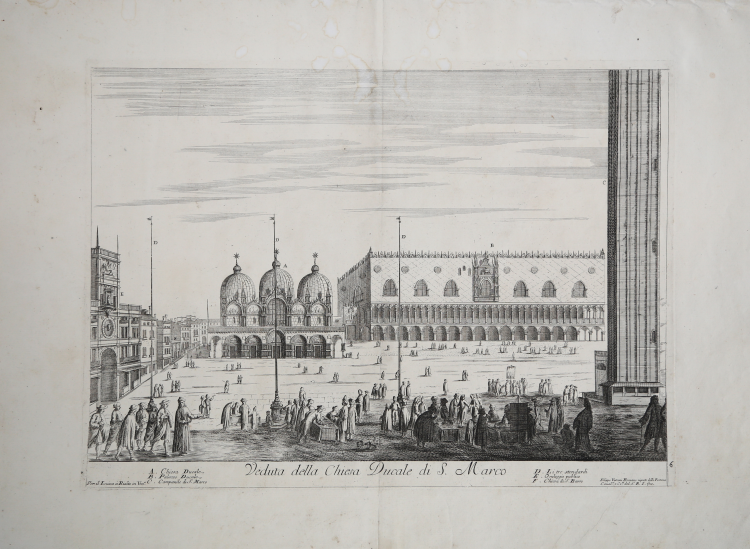



| Reference: | S5457 |
| Author | Domenico LOVISA |
| Year: | 1717 ca. |
| Measures: | 490 x 345 mm |


| Reference: | S5457 |
| Author | Domenico LOVISA |
| Year: | 1717 ca. |
| Measures: | 490 x 345 mm |
Etching, ca. 1717, signed in plate at lower right.
View of Venice taken from Il Gran Teatro di Venezia ovvero raccolta delle principali vedute e pitture che si contengono in essa, first published about 1717 by Domenico Lovisa, publisher in Venice in the first half of the 18th century. Consisting of 122 engravings, the work reproduces details of the city and works by major Venetian artists.
“Domenico Lovisa, who had a workshop in Rialto. Lovisa published, in 1715, a manifesto to publicize the initiative and find associates, and appealed to the doge to ask for "il benigno privileggio per anni venti acciò non venga coll'inferiori ristampe deturpata". Although, according to Gallo (1941), the request was not granted (the plates, in fact, lack the initials C. P. E.S., Cum Privilegio Excellentissimi Senatus) the work was first published -undated- most likely in 1717. The first edition bears the title Il Gran Teatro di Venezia ovvero raccolta delle principali vedute e pitture che si contengono in essa. The Collection includes 122 plates, as can be seen from the indexes contained in the first tome. The latter consists of 57 views of Venice that were engraved by Filippo Vasconi, Giuseppe Valeriani, Carlo and Andrea Zucchi and an anonymous engraver who initialed the plates with the initials S. F. It should also be pointed out that many views bear no signature. The second tome, comprising 65 plates, contains a series of reproductions of paintings, especially by Veronese, Tintoretto and Palma il Giovane, the engraving translation of which is mostly the responsibility of Domenico Rossetti and Andrea Zucchi from drawings by Silvestro Manaigo and the young Giambattista Tiepolo.
The second edition appeared in 1720 with the new title Il Gran Teatro delle pitture e prospettive di Venezia in due tomi diviso. Segue il Tomo primo. Nel quale si contengono le principale pitture pubbliche di questa città nobilissima disegnate e intagliate da eccellenti professori con l'indice nel principio e con l'esposizione delle medesime cavata dalla miniera della Pittura di Marco Boschini. In Venezia MDCCXX appresso Domenico Lovisa con licenza dei Superiori e privilegio. And Tomo secondo nel quale si contengono le prospettive delle fabbriche principali di questa Città nobilissima e dell'isole circonvicine dissegnate e intagliate da eccellenti professori. The collections contain a variable number of plates. According to Calabi, the most complete sylloge would include 57 plates from paintings and 66 plates with perspective views. A further edition was published by Viero, who added on the plates the inscription Appo T. Viero Venice. Pignatti (1968) wrote; “Although often reworkings of the Carlevarijs, the prints published by Lovisa are distinguished by a remarkable realistic vividness, especially in the clusters of speckles, which have a notable part in the whole. and by a pleasant luminosity. The uniform point of view, central and elevated, betrays the systematic use of the camera ottica: the formal elaboration varies in the hands dci different draftsmen and engravers [...]“” (cf. D. Succi, Da Carlevarijs a Tiepolo: incisori veneti e friulani del '700, p. 230).
Magnificent proof, printed on contemporary laid paper without watermark, with wide margins, traces of central vertical crease, slight browning in the margins, overall in very good condition.
Bibliografia
D. Succi, Da Carlevarijs a Tiepolo: incisori veneti e friulani del '700, pp. 230-234.
Domenico LOVISA (Venezia 1690 circa – 1750 circa)
|
Italian publisher. His printing press was situated 'underneath the arches at Rialto' in Venice, and he is known almost exclusively for the publication of a series of large prints, titled Il Gran Teatro di Venezia ovvero descrizione esatta di cento delle più insigni prospettive e di altretante celebri pitture della medesima città. The first edition is undated, but it probably came out c. 1717. As originally planned, the series was to include 200 prints, but this ambition was not realized, and even the second edition (1720, 2 vols) has only c. 120 prints. The approximately 57 plates contained in the first volume reproduce paintings that hung in Venetian public buildings, including works by Veronese, Titian, Tintoretto, Palma Giovane. They were engraved by Andrea Zucchi, Domenico Rossetti (1650-1736), Giacomo Burri, Domenico Bonavera (b 1640), Pietro Sante Bartoli, Agostino dalla Via and others. The second volume contains a varying number (up to 66) of views of Venice (see exh. Cat., figs 279-82) engraved by Filippo Vasconi (1687-1730), Giuseppe Valeriani (d 1761), Carlo and Andrea Zucchi, as well as an unidentified monogrammist, S.F. This series was reprinted a number of times in the 18th century.
|
Domenico LOVISA (Venezia 1690 circa – 1750 circa)
|
Italian publisher. His printing press was situated 'underneath the arches at Rialto' in Venice, and he is known almost exclusively for the publication of a series of large prints, titled Il Gran Teatro di Venezia ovvero descrizione esatta di cento delle più insigni prospettive e di altretante celebri pitture della medesima città. The first edition is undated, but it probably came out c. 1717. As originally planned, the series was to include 200 prints, but this ambition was not realized, and even the second edition (1720, 2 vols) has only c. 120 prints. The approximately 57 plates contained in the first volume reproduce paintings that hung in Venetian public buildings, including works by Veronese, Titian, Tintoretto, Palma Giovane. They were engraved by Andrea Zucchi, Domenico Rossetti (1650-1736), Giacomo Burri, Domenico Bonavera (b 1640), Pietro Sante Bartoli, Agostino dalla Via and others. The second volume contains a varying number (up to 66) of views of Venice (see exh. Cat., figs 279-82) engraved by Filippo Vasconi (1687-1730), Giuseppe Valeriani (d 1761), Carlo and Andrea Zucchi, as well as an unidentified monogrammist, S.F. This series was reprinted a number of times in the 18th century.
|